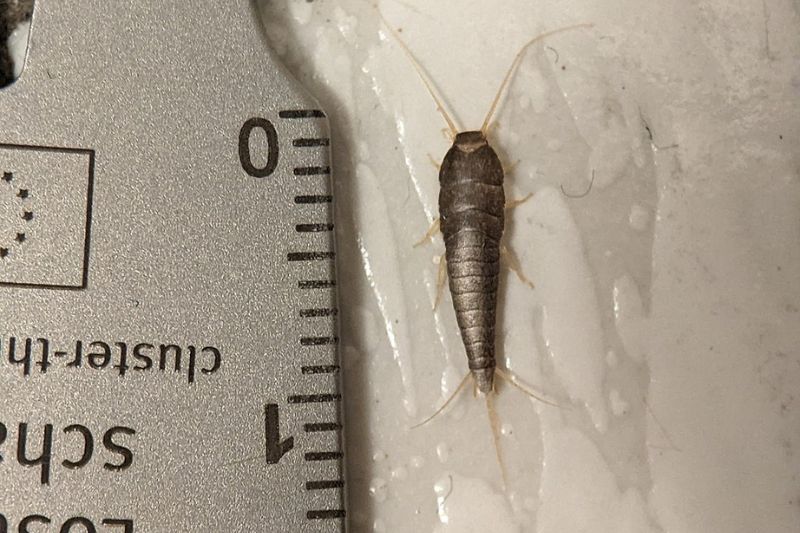Table of Contents
Introduction
Silverfish, those small, silvery insects that scuttle across your bedroom floor, can be more than just a nuisance. When they find their way onto your bed, it’s a clear sign of a potential infestation. Addressing this issue promptly is crucial for maintaining the hygiene and comfort of your sleeping area.
While they might not pose an immediate threat to your health, silverfish can wreak havoc on your bedding, linens, and even books left on the nightstand. Ignoring this problem could lead to more extensive infestations, making it even harder to get rid of them.
In this comprehensive guide, we’ll delve into the world of silverfish, exploring their habits and providing actionable steps to prevent and remove them from your bed. Let’s dive in and reclaim your peaceful night’s sleep.
Understanding Silverfish
Silverfish, scientifically known as Lepisma saccharina, are small, wingless insects characterized by their silvery-gray color and teardrop-shaped bodies. Measuring between 13 to 25 millimeters in length, they possess two long, slender antennae at their front and three tail-like appendages at the rear, giving them a distinctive appearance.
Habits and Habitat
These nocturnal creatures are primarily attracted to dark, damp environments, making bedrooms an ideal hiding spot. They thrive in areas with high humidity levels, often seeking refuge in cracks, crevices, and the folds of fabric.
Silverfish are not picky eaters. They feed on a variety of materials, including paper, cardboard, and fabrics like cotton and silk. This includes the linens and bedding on your bed, which can become targets for these pests if they manage to infiltrate your sleeping area.
Reproduction
Silverfish are prolific breeders, with females laying clusters of eggs in concealed locations. These eggs hatch into nymphs that closely resemble miniature versions of the adults. As they mature, silverfish molt, shedding their exoskeletons several times before reaching adulthood.
Lifespan
Under favorable conditions, silverfish can live for up to three years, allowing infestations to persist and grow if not addressed promptly.
Understanding the biology and habits of silverfish is the first step in effectively preventing and eliminating them from your bed and bedroom.
How Silverfish End Up on Beds
Understanding how silverfish find their way onto beds is crucial for implementing effective prevention measures. Here are some common scenarios:
1. Migration from Nearby Areas:
Silverfish are agile creatures capable of squeezing through tiny openings. They may migrate from adjacent rooms, particularly if those areas provide favorable conditions such as high humidity levels.
2. Infested Linens or Fabrics:
Silverfish are attracted to materials like cotton, silk, and even synthetic fabrics. If these materials are present on your bed, there’s a possibility that silverfish may be drawn to them.
3. Climbing Surfaces:
Silverfish are skilled climbers, able to ascend walls and other vertical surfaces with ease. From there, they may inadvertently find their way onto your bed.
4. Hidden Cracks and Crevices:
If your bed or bedroom furniture has small cracks or gaps, silverfish may use these as entry points. They often seek refuge in dark, concealed spaces during the day.
5. Contaminated Items:
If you bring in items that have been stored in infested areas, such as cardboard boxes or old books, silverfish could hitch a ride and eventually end up on your bed.
6. Ventilation Systems:
In some cases, silverfish can enter through ventilation ducts or gaps around windows and doors, eventually making their way to your sleeping area.
Understanding these potential entry points can help you take proactive measures to prevent silverfish from reaching your bed.
The Risks of Silverfish Infestation
While silverfish themselves are not harmful to humans, their presence on your bed can lead to several concerning issues:
1. Damage to Bedding and Linens:
Silverfish have a voracious appetite for various materials, including cotton, silk, and synthetic fabrics. If left unchecked, they can cause irreparable damage to your bedding, linens, and even clothing stored in your bedroom.
2. Stains and Fecal Matter:
As silverfish feed, they leave behind small droppings and, in some cases, may regurgitate, leading to unsightly stains on your bedding. These stains can be difficult to remove.
3. Allergies and Skin Irritation:
Although rare, some individuals may be sensitive to the proteins found in silverfish scales and feces. Prolonged exposure to these allergens can lead to skin irritation or respiratory issues in susceptible individuals.
4. Secondary Pest Infestations:
Silverfish are known to attract other pests, such as carpet beetles and spiders, which may also find their way onto your bed. This can lead to a more complex and challenging infestation to deal with.
5. Psychological Discomfort:
Knowing that your bed is infested with pests can lead to significant psychological distress, affecting your ability to sleep comfortably and peacefully.
Addressing a silverfish infestation promptly is crucial to prevent further damage and ensure your sleeping environment remains clean and comfortable.
Prevention Techniques
Implementing proactive measures is key to keeping silverfish away from your bed and bedroom. Here are some effective prevention techniques:
Keep a Clean Bedroom
Maintaining a clean and clutter-free bedroom is the first line of defense against silverfish:
- Regular Vacuuming: Vacuum your bedroom floors, especially around the bed and along baseboards, to remove crumbs and debris that can attract silverfish.
- Dusting: Dust all surfaces, including headboards, nightstands, and dressers, to eliminate potential hiding spots.
- Laundry Routine: Wash bedding, curtains, and other linens regularly to prevent the buildup of food particles and moisture.
Sealing Entry Points
Preventing silverfish from entering your bedroom is crucial:
- Seal Cracks and Gaps: Inspect your bedroom for any cracks, gaps, or openings in walls, floors, and windows. Seal these entry points using caulk or other appropriate materials.
- Install Door Sweeps: Use door sweeps to seal the gap between the bottom of exterior doors and the floor, preventing silverfish from squeezing through.
Reduce Moisture Levels
Silverfish thrive in humid environments, so reducing moisture levels is essential:
- Use Dehumidifiers: Install a dehumidifier in your bedroom to maintain optimal humidity levels, typically between 40-50%.
- Ventilation: Ensure good airflow by using fans or opening windows, especially in areas prone to high humidity.
By incorporating these prevention techniques, you’ll create an environment that’s less appealing to silverfish, reducing the likelihood of infestations.
Natural Remedies for Silverfish Removal
For those who prefer eco-friendly alternatives, several natural remedies can help eliminate silverfish from your bedroom:
Diatomaceous Earth
Diatomaceous earth is a natural powder made from fossilized algae. It’s safe for humans and pets but deadly to insects like silverfish. Sprinkle it in areas where silverfish are likely to hide, such as along baseboards and in cracks and crevices.
Cedar Oil
Cedar oil is a natural insect repellent. Apply a few drops onto cotton balls and place them in areas where silverfish are active. The scent of cedar will deter them.
Essential Oils
Certain essential oils, such as lavender, citrus, and peppermint, have insect-repelling properties. Mix a few drops with water in a spray bottle and mist areas where silverfish are present.
Boric Acid
Boric acid is a naturally occurring mineral that is toxic to silverfish but safe for humans and pets in small quantities. Apply a thin layer in areas frequented by silverfish.
Citrus Peels
Save your citrus peels and place them in areas where silverfish are likely to hide. The natural oils in the peels act as a deterrent.
These natural remedies provide effective alternatives to chemical treatments, allowing you to address the issue in an eco-friendly manner.
Chemical Treatments (if necessary)
While natural remedies are often effective, there may be situations where a more aggressive approach is needed. In such cases, consider the following:
Insecticidal Sprays
Commercial insecticidal sprays formulated for silverfish can be effective in eliminating infestations. However, exercise caution and follow the manufacturer’s instructions closely. Ensure proper ventilation during application and keep pets and children away from treated areas.
Desiccant Dusts
Desiccant dusts are fine powders that work by dehydrating insects. They can be applied in cracks, crevices, and other hiding spots frequented by silverfish. As with insecticidal sprays, use them according to the product’s instructions.
Professional Pest Control
If the infestation persists despite your efforts, it may be time to seek the expertise of a professional pest control service. Experienced technicians have access to specialized equipment and treatments that can effectively eradicate silverfish infestations.
Remember, chemical treatments should always be used as a last resort and applied with caution to ensure the safety of occupants and pets.
Regular Inspections and Maintenance
Maintaining vigilance and conducting routine inspections are essential for preventing future silverfish infestations. Here’s how you can stay proactive:
Schedule Regular Checks
Set aside time every month to inspect your bedroom for any signs of silverfish activity. Focus on areas where they are likely to hide, such as along baseboards, in cracks, and around windows.
Address Issues Promptly
If you discover any signs of silverfish, take immediate action to eliminate them. Use natural remedies or, if necessary, consult a pest control professional.
Maintain a Clutter-Free Environment
Continuously keep your bedroom free of unnecessary clutter. This reduces hiding spots for silverfish and makes it easier to spot any potential infestations.
Check Stored Items
Regularly inspect stored items, such as books, clothing, and linens, for any signs of silverfish activity. Consider using airtight containers or sealed bags to protect these items.
By incorporating regular inspections into your household routine, you’ll be better equipped to identify and address silverfish infestations in their early stages.
When to Seek Professional Help
While DIY methods are effective in many cases, there are situations where professional intervention is warranted. Here are scenarios when it’s advisable to consult a pest control expert:
Extensive Infestations
If the silverfish infestation has spread to multiple areas of your home or has become particularly severe, a professional pest control service can offer the expertise and resources needed to effectively eradicate the pests.
Persistent Infestations
If your efforts to eliminate silverfish have been unsuccessful over an extended period, it’s a sign that the infestation may be more complex than it appears. A pest control expert can conduct a thorough assessment and implement targeted treatments.
Health Concerns
If you or any household members experience allergic reactions or respiratory issues that may be linked to silverfish infestations, seek professional advice promptly. They can evaluate the situation and recommend appropriate measures to safeguard your health.
Infestations in Sensitive Areas
If silverfish have infested areas where there are valuable or sensitive items, such as libraries, archives, or antique collections, a professional pest control service can provide specialized solutions to protect these items.
Structural Damage
If you suspect that silverfish have caused damage to the structure of your home, including walls, insulation, or wallpaper, it’s crucial to consult a professional to assess and address the extent of the damage.
Remember, professional pest control experts have the training, experience, and access to specialized equipment and treatments that can effectively address challenging infestations.
Conclusion
In the battle against silverfish infestations on beds, knowledge and proactive prevention are your greatest allies. By understanding the habits and behavior of these pests, you can take effective measures to keep them away from your sleeping area.
Regular cleaning, sealing entry points, and controlling moisture levels are foundational steps in preventing silverfish from infiltrating your bedroom. Natural remedies, such as diatomaceous earth and essential oils, offer eco-friendly solutions for those who prefer non-chemical approaches.
In cases where the infestation persists or becomes extensive, seeking professional help is a prudent step. Pest control experts have the expertise and resources to tackle even the most challenging silverfish infestations.
Remember, addressing silverfish on your bed promptly is crucial for maintaining a clean, comfortable sleeping environment. By incorporating these prevention and removal techniques into your household routine, you can enjoy peaceful nights without the worry of unwanted guests.








